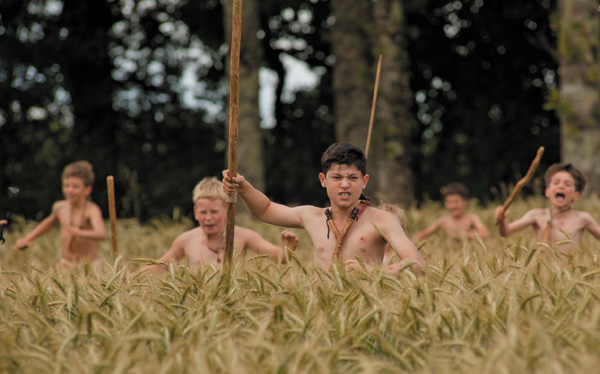New film version of ‘War of the Buttons’ set in Nazi-occupied France
Published October 31, 2012
A children’s “war” serves as a metaphor for the real thing in “War of the Buttons,” a film about doing the right thing in Nazi-occupied France.
Near an idyllic-looking French rural village, two boys walking down a country path come across boys from a neighboring village hunting rabbits on their “turf.” The encounter leads to an exchange of bravado and a “war” between gangs of boys in the villages, in which the rival gang’s buttons are taken as war prizes.
The film is based on the 1912 French novel by Louis Pergaud, which was also dramatized as a film in 1962 and 1994. For this film, the setting is Nazi-occupied France. The boys wage their own war in the countryside, far from the real battles of World War II. Pre-teen rebel Lebrac (Jean Texier) is the leader of the village boys who launch a “war” against the other town’s gang, led by a boy known as “the Aztec” (Thomas Goldberg). When a pretty new girl with dark, curly hair named Violette (Ilona Bachelier) moves to town, Lebrac takes notice.
Violette is described as the “god child” of the village tailor Simone (Laetitia Casta), who has returned to her native village after living in Paris. The boys’ teacher (Guillaume Canet), who tries to teach tolerance, learns the dark-haired, cultured girl has a secret — she’s Jewish.
The village is subjected to Nazi brutality, as they round up a Jewish family living there. Yet the village is so remote that the Nazis only pass through occasionally, mostly leaving oversight to the mayor and local authorities. But in such a tiny village, keeping secrets is not easy.
The photography is serene, lush and picture-perfect in “War of the Buttons.” The visual beauty draws the audience in and evokes a kind of polished “Disney” film feeling but, of course, there is an irony in the film’s visual prettiness. The boys’ “war” becomes a reflection of the real war around them but when the real threat intrudes, the boys are faced with a moral choice.
The film is produced by Thomas Langmann (“The Artist”) and directed by Academy Award nominee Christophe Barratier, who also helmed the lovely “Paris 36,” another film about Nazis in France.
This crowd-pleasing, uplifting film is family-friendly with a message of doing the right thing, making it both appropriate for pre-teen filmgoers and with enough intellectual weight to appeal to grown-ups. A few scenes may be too intense for the grade schoolers but for the most part the film is dramatic and involving without being harsh or graphic.
The production is as polished as the photography, with careful attention to historical details in costumes and sets. The acting is winning, with both fine performances by the adult cast and the younger cast members. Particularly appealing is Clement Godfroy, who plays a kind of comic relief as the smallest member of the gang. Jean Texier and Ilona Bachelier are charming as the pre-teen couples. In one endearing scene, the director adds clever visual references to “Romeo and Juliet,” but young Texier and Bachelier add comic touches to keep the scene sweet and light. Goldberg is particularly good as the menacing “Aztec” who leads the other gang.
This lovely, thoughtful film is a sure crowd-pleaser that has already won over audiences in other countries and cities.















